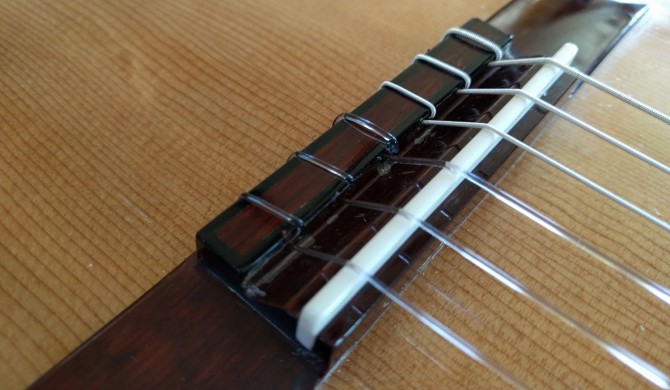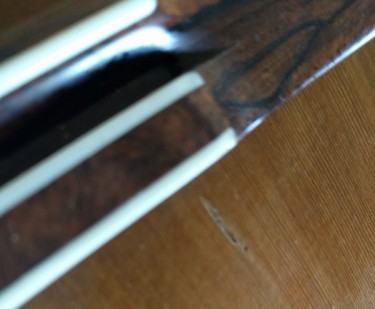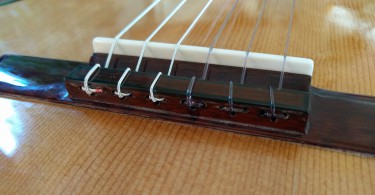
17
2015In the world of classical guitars we all learned to string bridges with six holes. Simple – one hole per string, or so it seemed. The various antics to hold each string in place, especially those slippery trebles, is often an exercise in classical guitar gymnastics, especially while trying to turn the corresponding tuner with the left hand, the guitar precariously balanced on the lap while the right index fingernail holds the loop of a treble spring on the bridge.
Aside the antics, there are two issues stringing a traditional 6-hole classical guitar – the first is trying to keep the treble strings steady while tensioning, that is, unless one performs a wrap knot, which I don’t particularly care for. The second is having a treble string that comes loose at the tie block, whips around, its tip slapping the soundboard behind the bridge and gashing the top.
Got a lighter? Good, since one technique involves swelling the bridge-side string end of those pesky trebles with a flame. For the 6-hole, swelling the treble string tips with a lighter is my preferred approach. But seriously, though, there has to be a better way. And there is – the 18-hole tie block.
A Better Tie Block – The 18-Hole Bridge
For each string, three holes are drilled into the tie block. Two of those holes go all the way through the tie block, while the third rightmost hole is drilled from the rear and stops halfway into the tie block. This “half hole” is where the string end is ultimately placed. Let’s take a look at some of the benefits:
- String ends are cleanly concealed in the tie block, in the 3rd half hole.
- Since the string end is trapped in the tie block, it cannot come loose. This prevents top damage that can occur from the dreaded string slap, as shown in the photo above.
-
Stringing the guitar is actually far more simple than a 6-hole bridge. Once the tie block is strung one can simply lead the string to the tuner and tension, without the gymnastics of holding the string in place at the bridge.
- If you wish to string the guitar as a 12-hole tie block, that can be done.
- With a 12-hole or 18-hole tie block, the break angle increases over a 6-hole – that is, the downward angle of the string from the saddle to the hole is significantly increased. This can be good for sound, and also helpful if neck angle changes over time have caused the saddle to be filed down. This prolongs the need for “slipping the heel” on a spanish neck guitar or doing a neck reset on a more modern neck construction.
In the next article, we’ll walk through a step-by-step stringing of an 18-hole bridge. Hopefully the above information gives some food for thought for converting a 6-hole to an 18-hole, or ordering your new classical with an 18-hole bridge.


